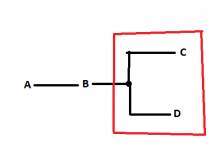I know in some circumstances you cannot combine series ratings.
But what about this scenario, is this an exception:
Fuse A = 300kAIC
Fuse B = 200kAIC
Breaker C = 65kAIC
Breaker D = 65kAIC
Fuse A and B are in series and feed breakers C and D as shown below. Let's pretend breakers C and D are in a standalone panelboard labelled red.
A is series rated with C at 100kAIC
B is series rated with D at 100kAIC
A does not series rate with D
B does not series rate with C
Is it correct to say that the red panelboard is series rated at 100kAIC?

But what about this scenario, is this an exception:
Fuse A = 300kAIC
Fuse B = 200kAIC
Breaker C = 65kAIC
Breaker D = 65kAIC
Fuse A and B are in series and feed breakers C and D as shown below. Let's pretend breakers C and D are in a standalone panelboard labelled red.
A is series rated with C at 100kAIC
B is series rated with D at 100kAIC
A does not series rate with D
B does not series rate with C
Is it correct to say that the red panelboard is series rated at 100kAIC?

